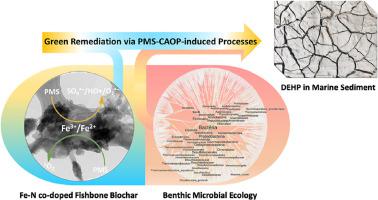当前位置:
X-MOL 学术
›
Environ. Pollut.
›
论文详情
Our official English website, www.x-mol.net, welcomes your feedback! (Note: you will need to create a separate account there.)
Advanced sustainable processes via functionalized Fe–N co-doped fishbone biochar for the remediation of plasticizer di-(2-ethylhexyl) phthalate-contaminated marine sediment
Environmental Pollution ( IF 8.9 ) Pub Date : 2024-03-26 , DOI: 10.1016/j.envpol.2024.123861 Cheng-Di Dong , Chin-Pao Huang , Chiu-Wen Chen , Chang-Mao Hung
Environmental Pollution ( IF 8.9 ) Pub Date : 2024-03-26 , DOI: 10.1016/j.envpol.2024.123861 Cheng-Di Dong , Chin-Pao Huang , Chiu-Wen Chen , Chang-Mao Hung

|
Sediments are important sinks for di-(2-ethylhexyl) phthalate (DEHP), a plasticizer, and thus, maintaining the sediment quality is essential for eliminating plasticizers in aqueous environments and recovering the sediment ecological functions. To mitigate the potential risks of endocrine-disrupting compounds, identifying an effective and eco-friendly degradation process of organic pollutants from sediments is important. However, sustainable and efficient utilization of slow pyrolysis for converting shark fishbone to generate shark fishbone biochar (SFBC) has rarely been explored. Herein, SFBC biomass was firstly produced by externally incorporating heteroatoms or iron oxide onto its surface in conjunction with peroxymonosulfate (PMS) to promote DEHP degradation and explore the associated benthic bacterial community composition from the sediment in the water column using the Fe-N-SFBC/PMS system. SFBC was pyrolyzed at 300–900 °C in aqueous sediment using a carbon-advanced oxidation process (CAOP) system based on PMS. SFBC was rationally modified via N or Fe–N doping as a radical precursor in the presence of PMS (1 × 10 M) for DEHP removal. The innovative SFBC/PMS, N-SFBC/PMS, and Fe-N-SFBC/PMS systems could remove 82%, 65%, and 90% of the DEHP at pH 3 in 60 min, respectively. The functionalized FeO and heteroatom (N) co-doped SFBC composite catalysts within a hydroxyapatite-based structure demonstrated the efficient action of PMS compared to pristine SFBC, which was attributed to its synergistic behavior, generating reactive radicals (SO, HO•, and O) and non-radicals (O) involved in DEHP decontamination. DEHP was significantly removed using the combined Fe-N-SFBC/PMS system, revealing that indigenous benthic microorganisms enhance their performance in DEHP-containing sediments. Further, DEHP-induced perturbation was particularly related to the phylum, whereas genus and species were observed. This study presents a sustainable method for practical, green marine sediment remediation via PMS-CAOP-induced processes using a novel Fe-N-SFBC composite material and biodegradation synergy.
中文翻译:

通过功能化铁氮共掺杂鱼骨生物炭修复增塑剂邻苯二甲酸二(2-乙基己基)污染的海洋沉积物的先进可持续工艺
沉积物是增塑剂邻苯二甲酸二(2-乙基己基)酯(DEHP)的重要汇,因此,保持沉积物质量对于消除水环境中的增塑剂和恢复沉积物生态功能至关重要。为了减轻内分泌干扰化合物的潜在风险,确定沉积物中有机污染物的有效且生态友好的降解过程非常重要。然而,可持续、高效地利用缓慢热解将鲨鱼鱼骨转化为鲨鱼鱼骨生物炭(SFBC)的研究却很少。在此,SFBC生物质首先通过在其表面外部掺入杂原子或氧化铁与过一硫酸盐(PMS)结合来促进DEHP降解,并使用Fe-N-SFBC从水体沉积物中探索相关的底栖细菌群落组成/经前综合症系统。使用基于 PMS 的碳高级氧化工艺 (CAOP) 系统在 300–900 °C 的水沉积物中热解 SFBC。在 PMS (1 × 10 M) 存在下,通过 N 或 Fe-N 掺杂作为自由基前体,对 SFBC 进行合理修饰,以去除 DEHP。创新的 SFBC/PMS、N-SFBC/PMS 和 Fe-N-SFBC/PMS 系统可在 60 分钟内分别去除 pH 3 下 82%、65% 和 90% 的 DEHP。与原始 SFBC 相比,基于羟基磷灰石结构的功能化 FeO 和杂原子 (N) 共掺杂 SFBC 复合催化剂证明了 PMS 的高效作用,这归因于其协同行为,产生反应性自由基(SO、HO• 和 O) )和非自由基(O)参与 DEHP 去污。使用 Fe-N-SFBC/PMS 组合系统可显着去除 DEHP,这表明本土底栖微生物增强了其在含 DEHP 沉积物中的性能。此外,DEHP 引起的扰动与门特别相关,而观察到属和种。本研究提出了一种利用新型 Fe-N-SFBC 复合材料和生物降解协同作用,通过 PMS-CAOP 诱导过程进行实用、绿色海洋沉积物修复的可持续方法。
更新日期:2024-03-26
中文翻译:

通过功能化铁氮共掺杂鱼骨生物炭修复增塑剂邻苯二甲酸二(2-乙基己基)污染的海洋沉积物的先进可持续工艺
沉积物是增塑剂邻苯二甲酸二(2-乙基己基)酯(DEHP)的重要汇,因此,保持沉积物质量对于消除水环境中的增塑剂和恢复沉积物生态功能至关重要。为了减轻内分泌干扰化合物的潜在风险,确定沉积物中有机污染物的有效且生态友好的降解过程非常重要。然而,可持续、高效地利用缓慢热解将鲨鱼鱼骨转化为鲨鱼鱼骨生物炭(SFBC)的研究却很少。在此,SFBC生物质首先通过在其表面外部掺入杂原子或氧化铁与过一硫酸盐(PMS)结合来促进DEHP降解,并使用Fe-N-SFBC从水体沉积物中探索相关的底栖细菌群落组成/经前综合症系统。使用基于 PMS 的碳高级氧化工艺 (CAOP) 系统在 300–900 °C 的水沉积物中热解 SFBC。在 PMS (1 × 10 M) 存在下,通过 N 或 Fe-N 掺杂作为自由基前体,对 SFBC 进行合理修饰,以去除 DEHP。创新的 SFBC/PMS、N-SFBC/PMS 和 Fe-N-SFBC/PMS 系统可在 60 分钟内分别去除 pH 3 下 82%、65% 和 90% 的 DEHP。与原始 SFBC 相比,基于羟基磷灰石结构的功能化 FeO 和杂原子 (N) 共掺杂 SFBC 复合催化剂证明了 PMS 的高效作用,这归因于其协同行为,产生反应性自由基(SO、HO• 和 O) )和非自由基(O)参与 DEHP 去污。使用 Fe-N-SFBC/PMS 组合系统可显着去除 DEHP,这表明本土底栖微生物增强了其在含 DEHP 沉积物中的性能。此外,DEHP 引起的扰动与门特别相关,而观察到属和种。本研究提出了一种利用新型 Fe-N-SFBC 复合材料和生物降解协同作用,通过 PMS-CAOP 诱导过程进行实用、绿色海洋沉积物修复的可持续方法。



























 京公网安备 11010802027423号
京公网安备 11010802027423号